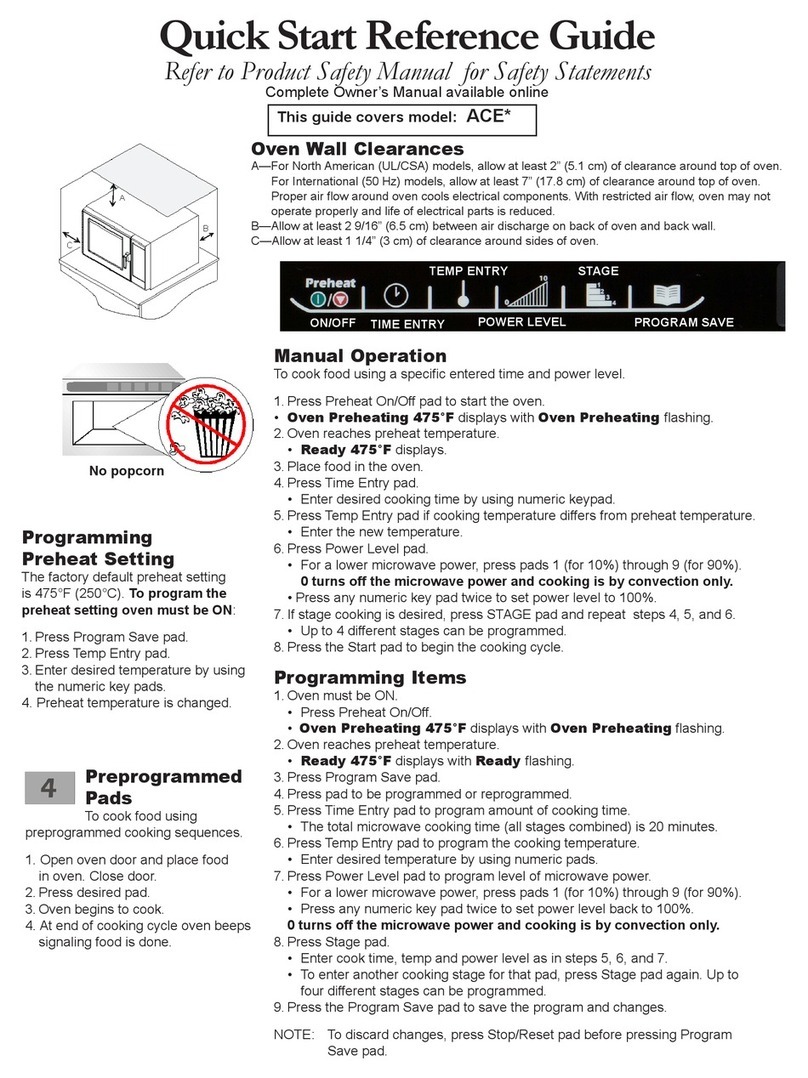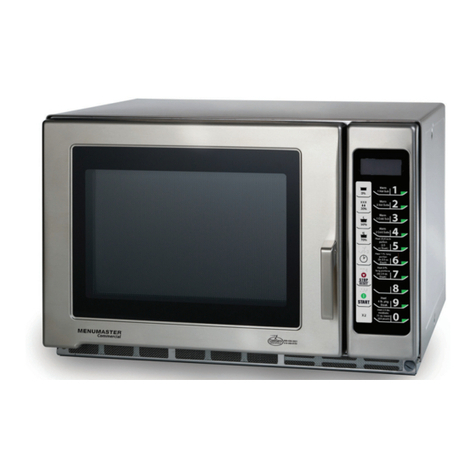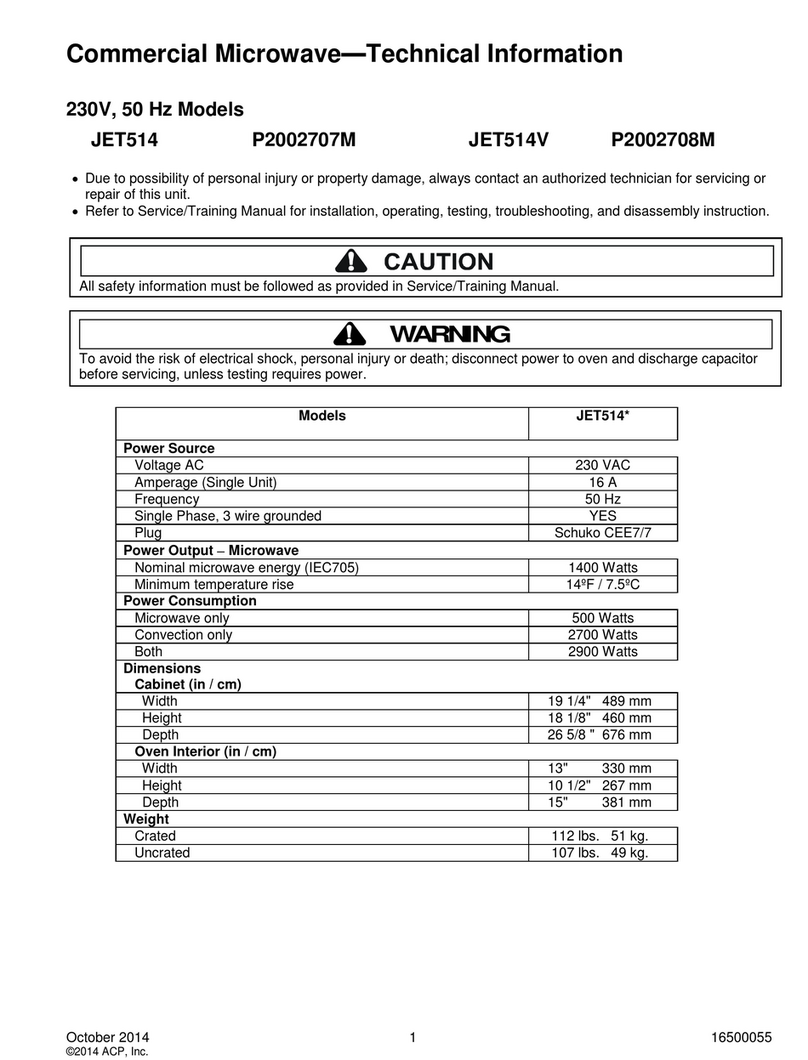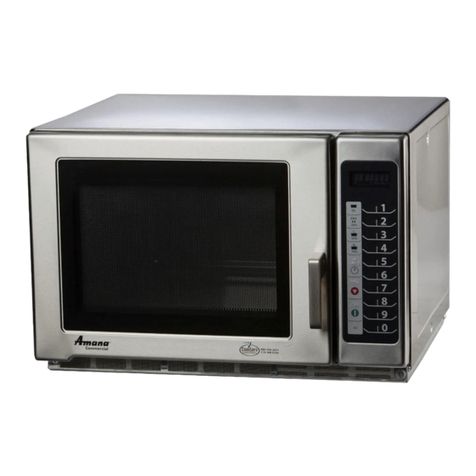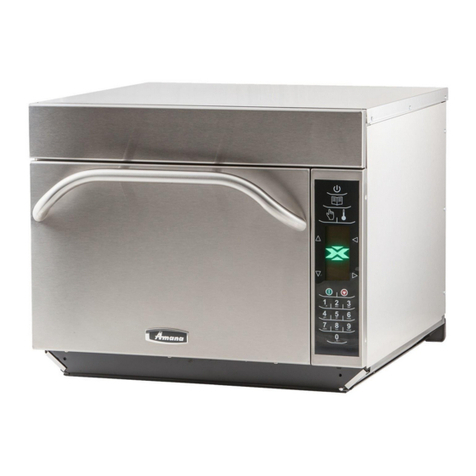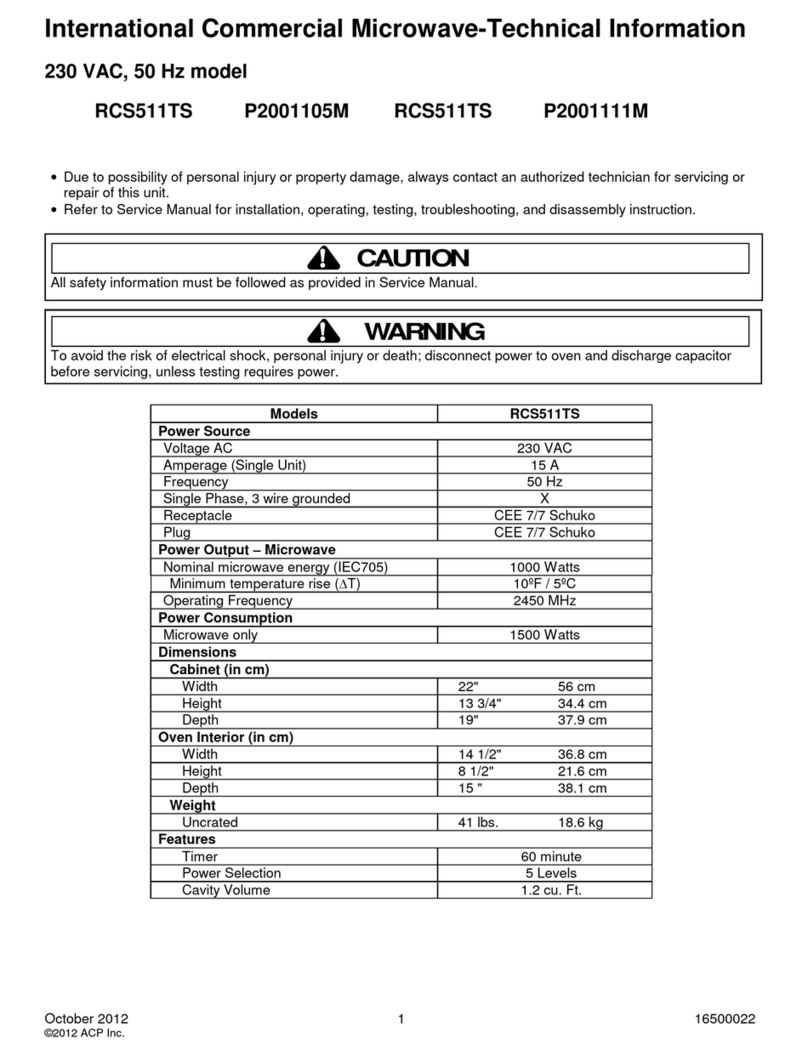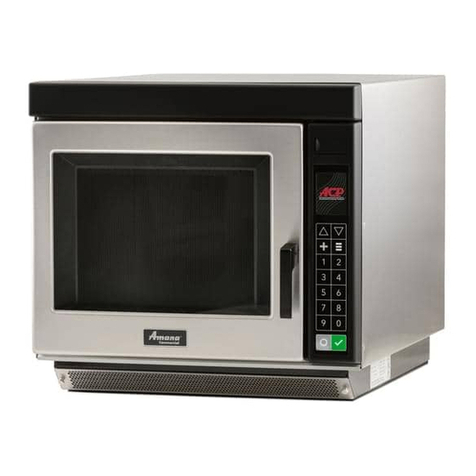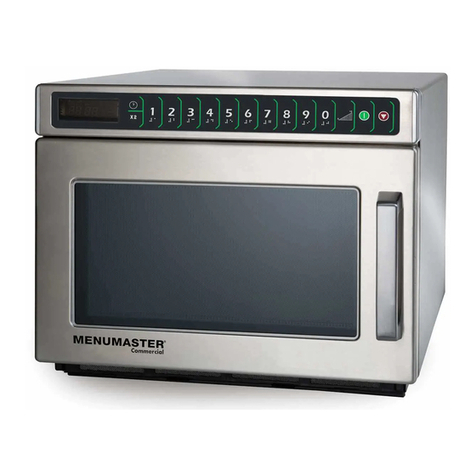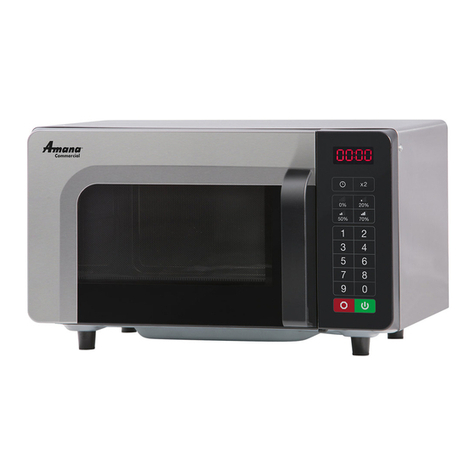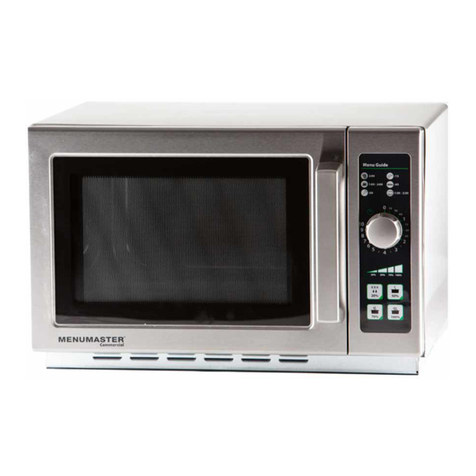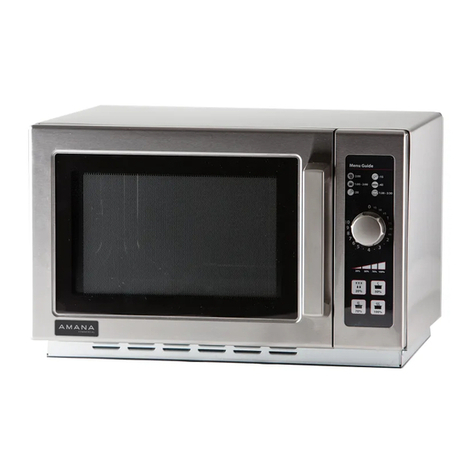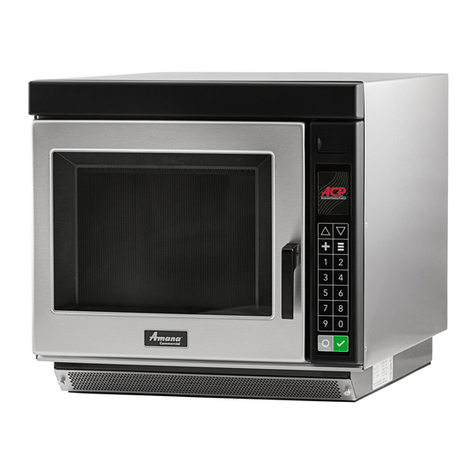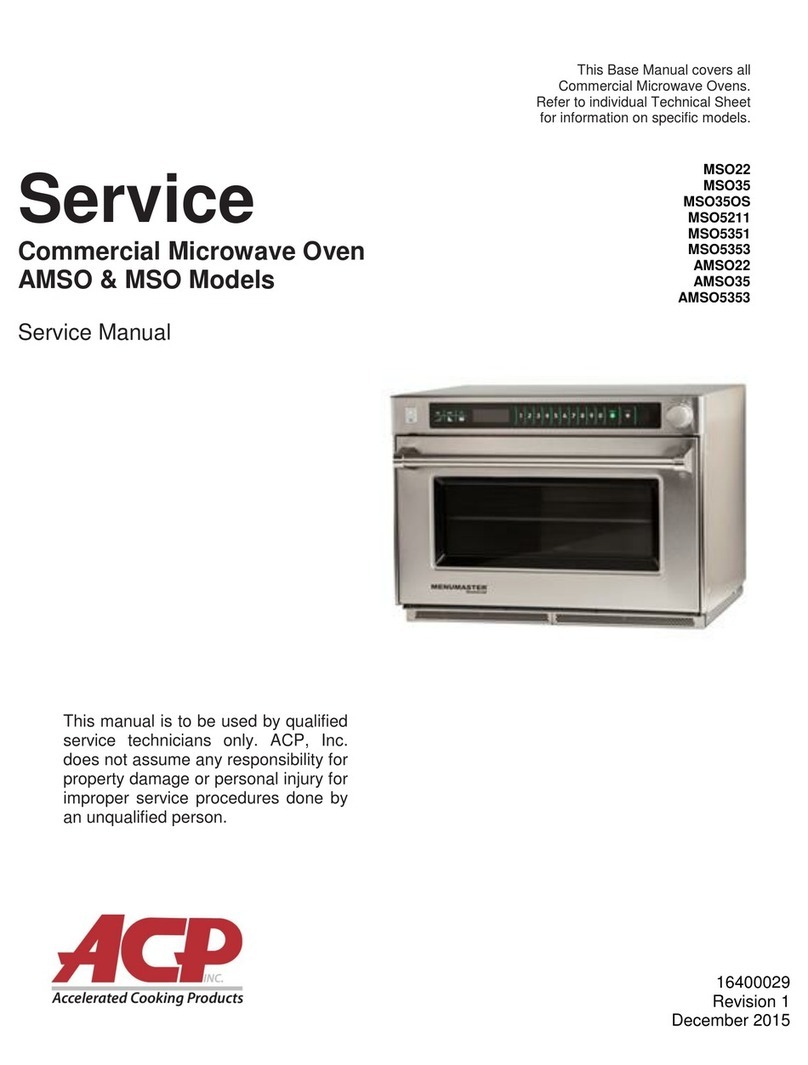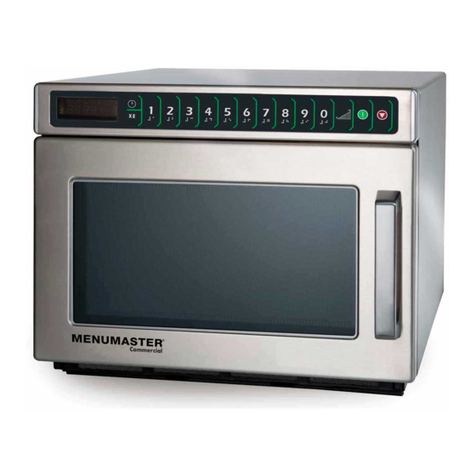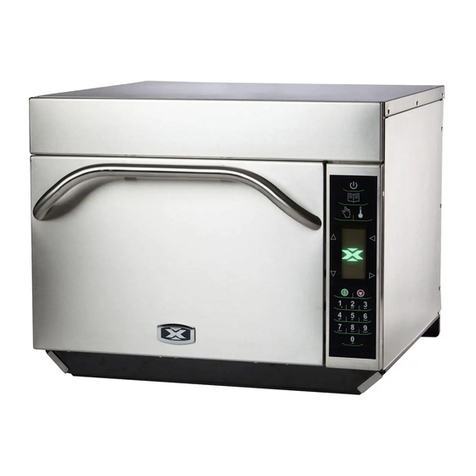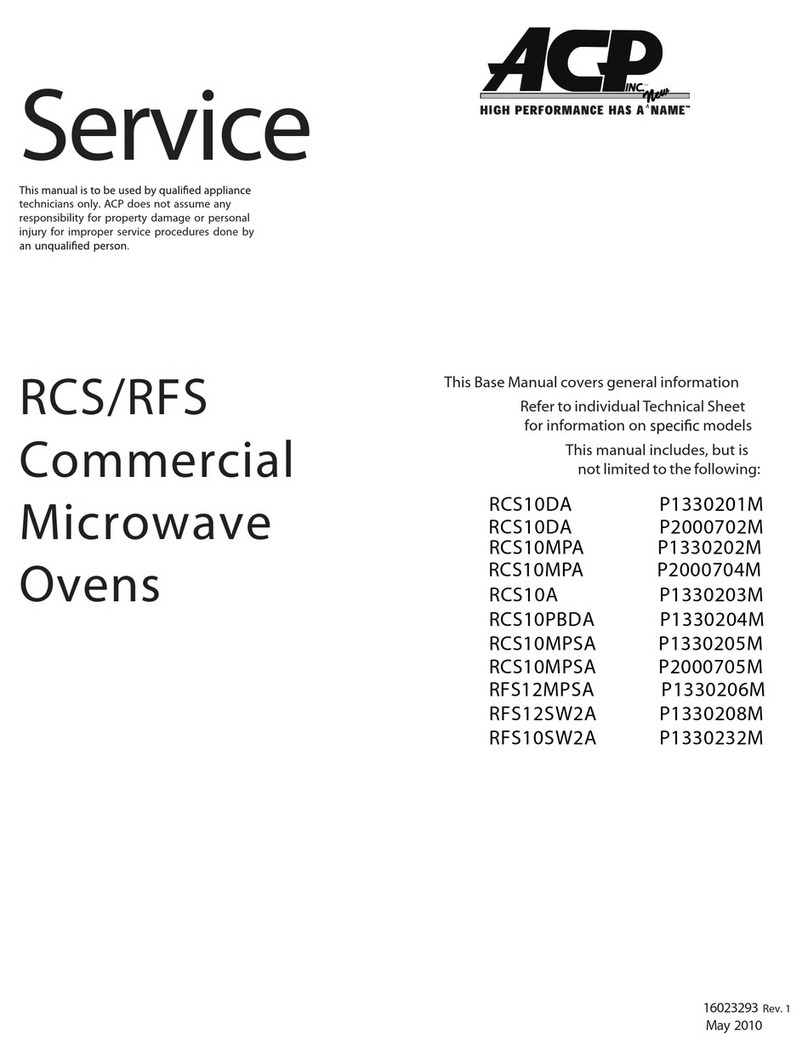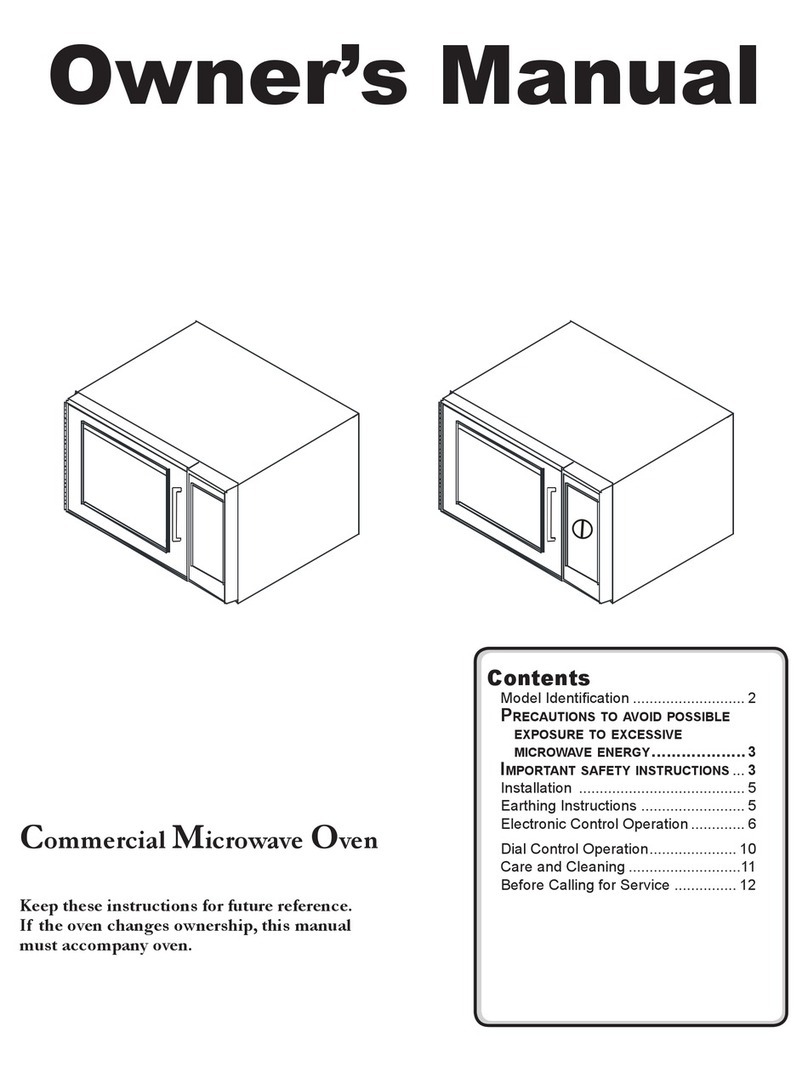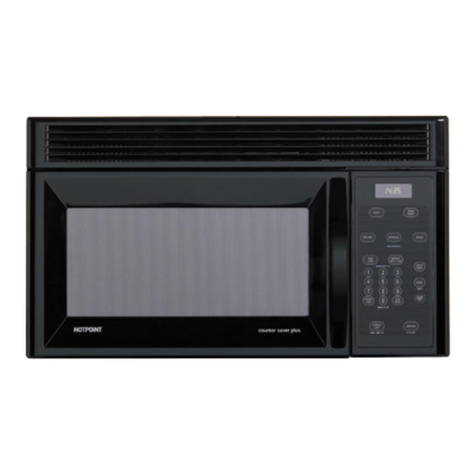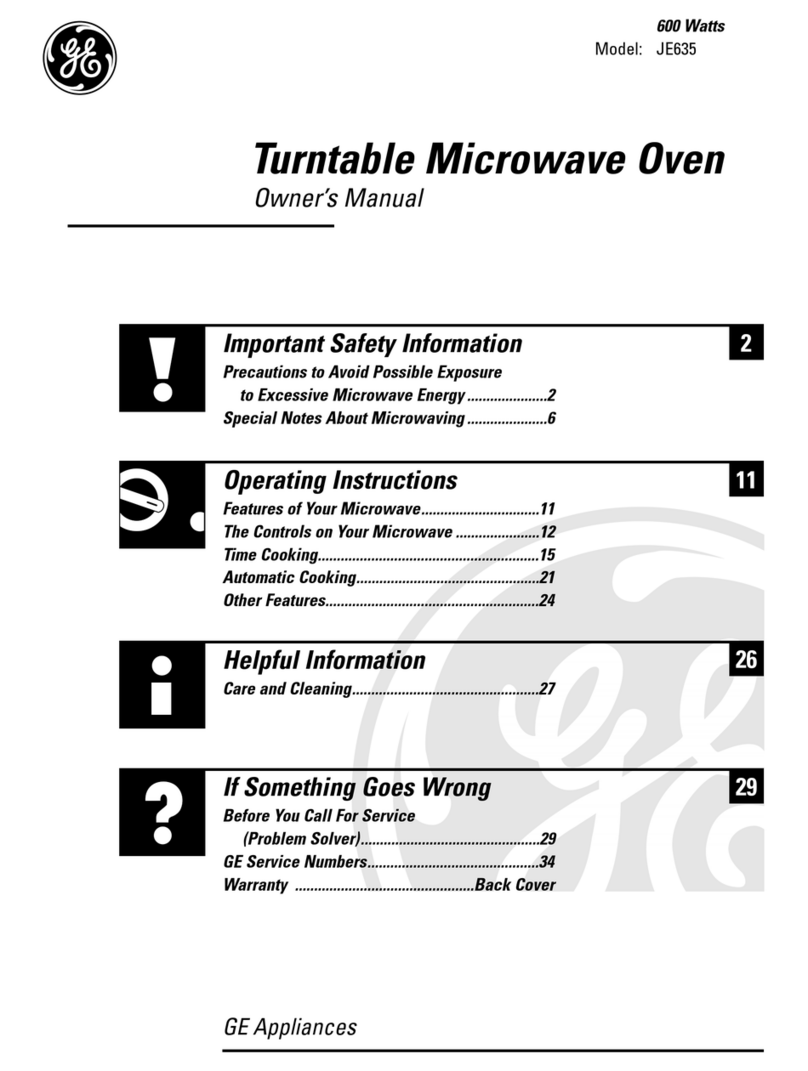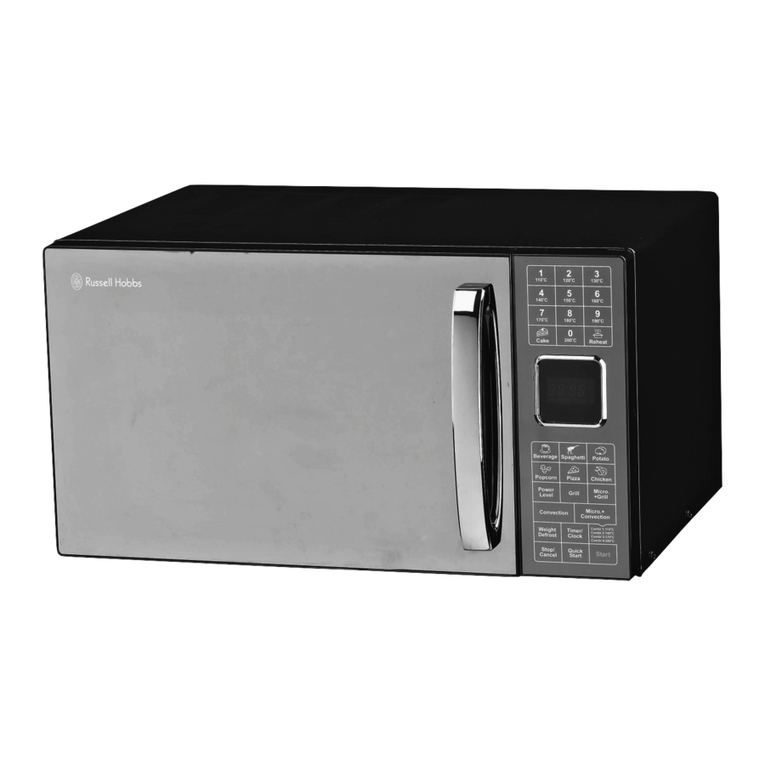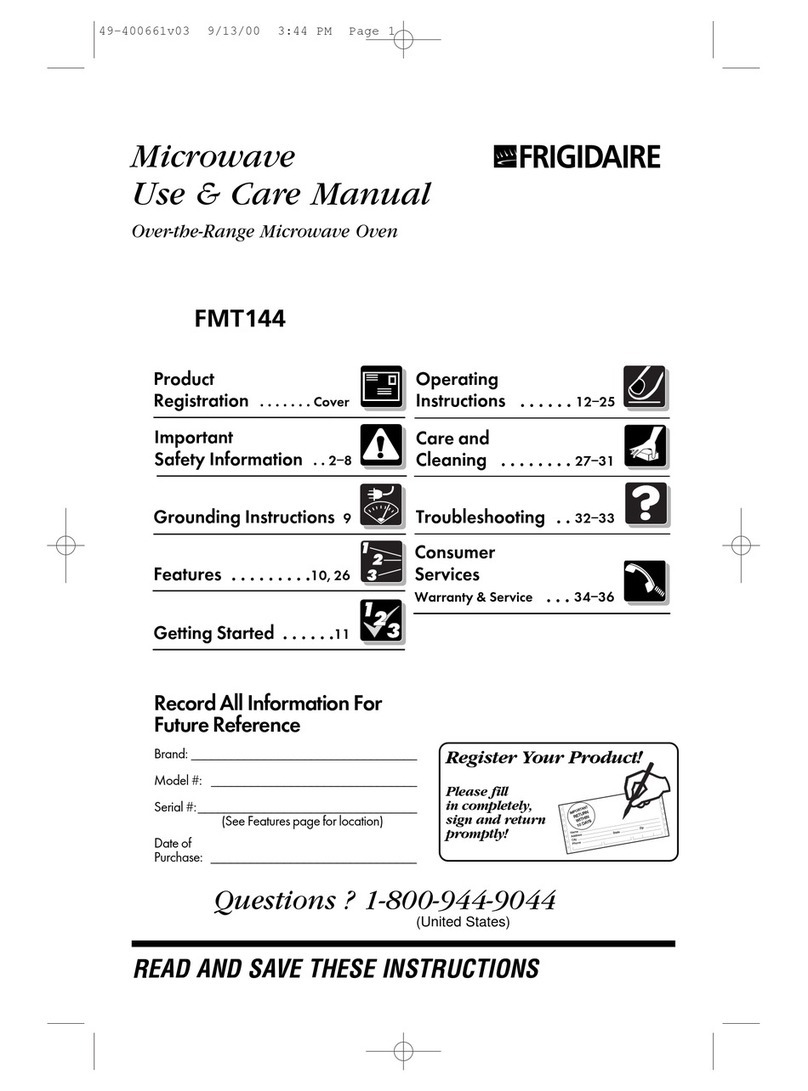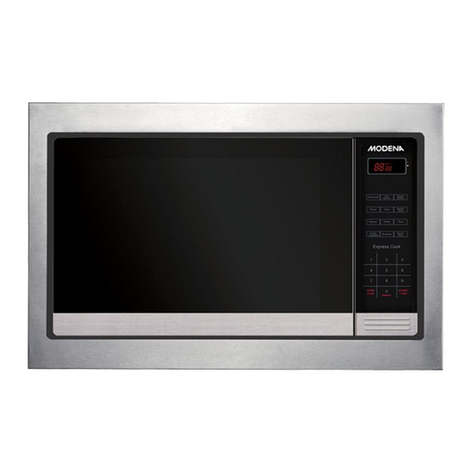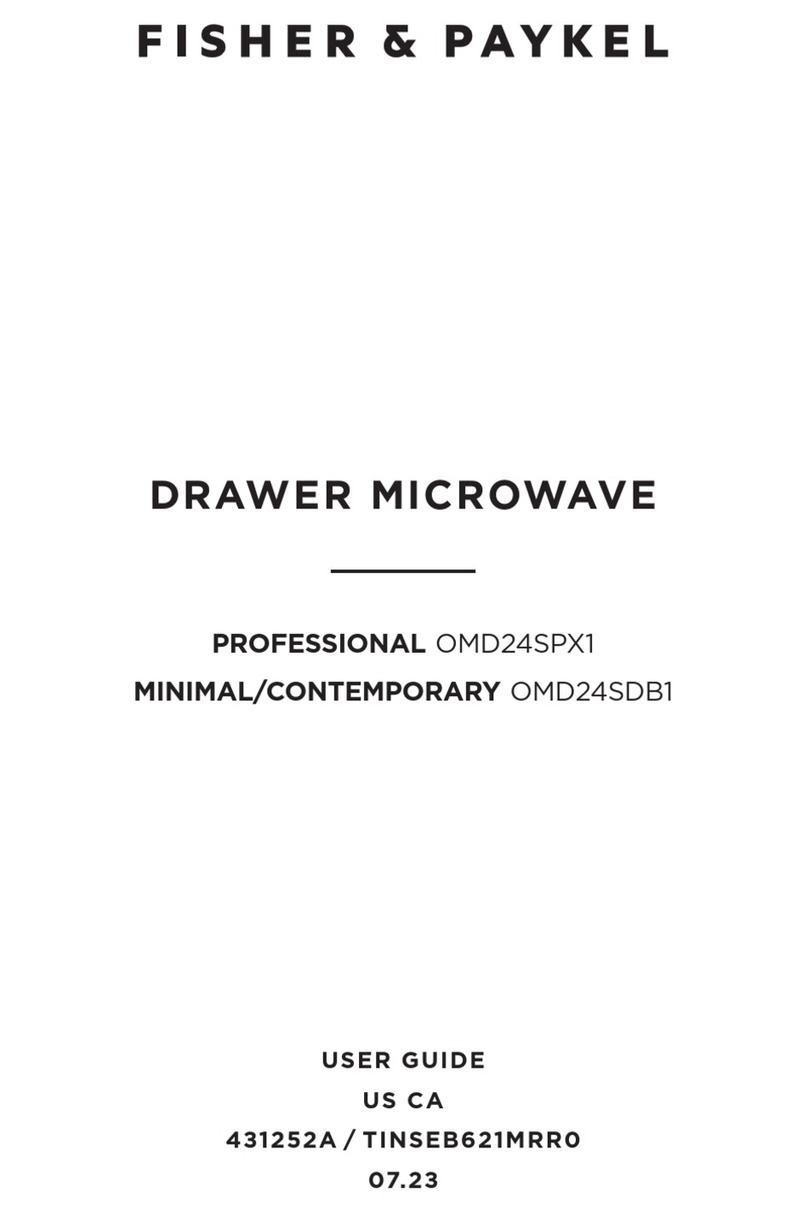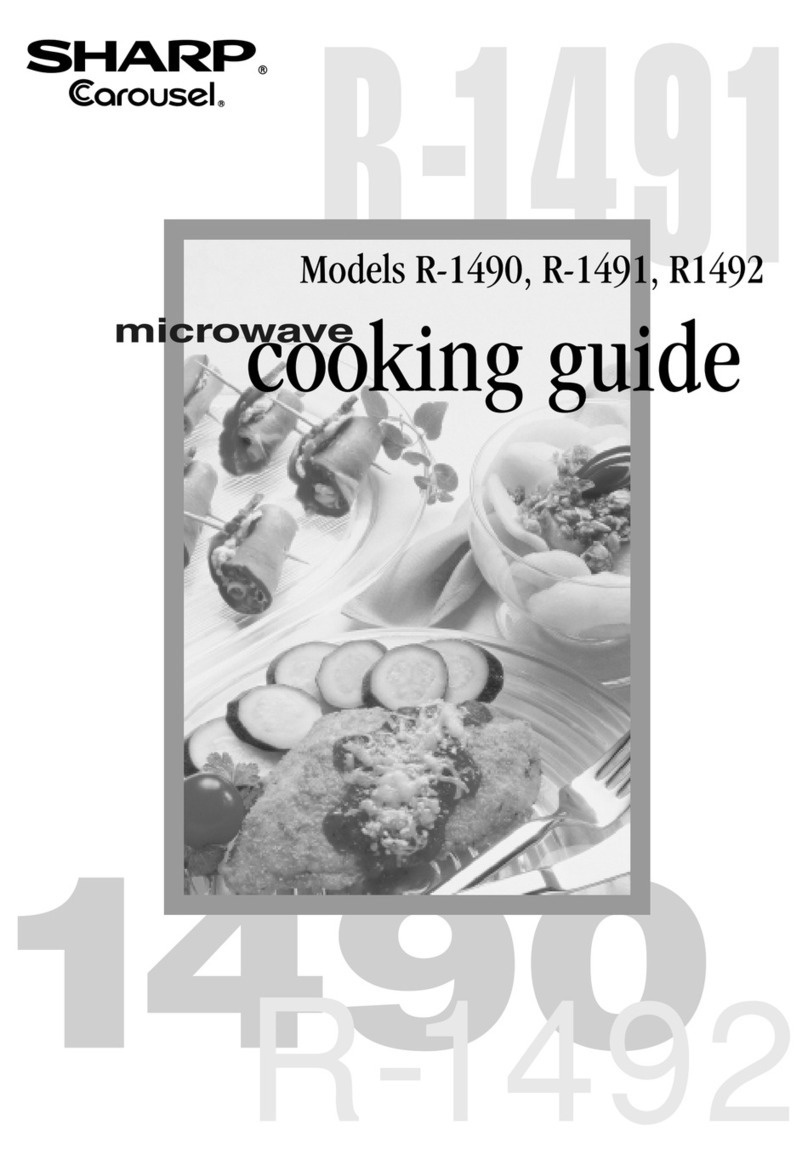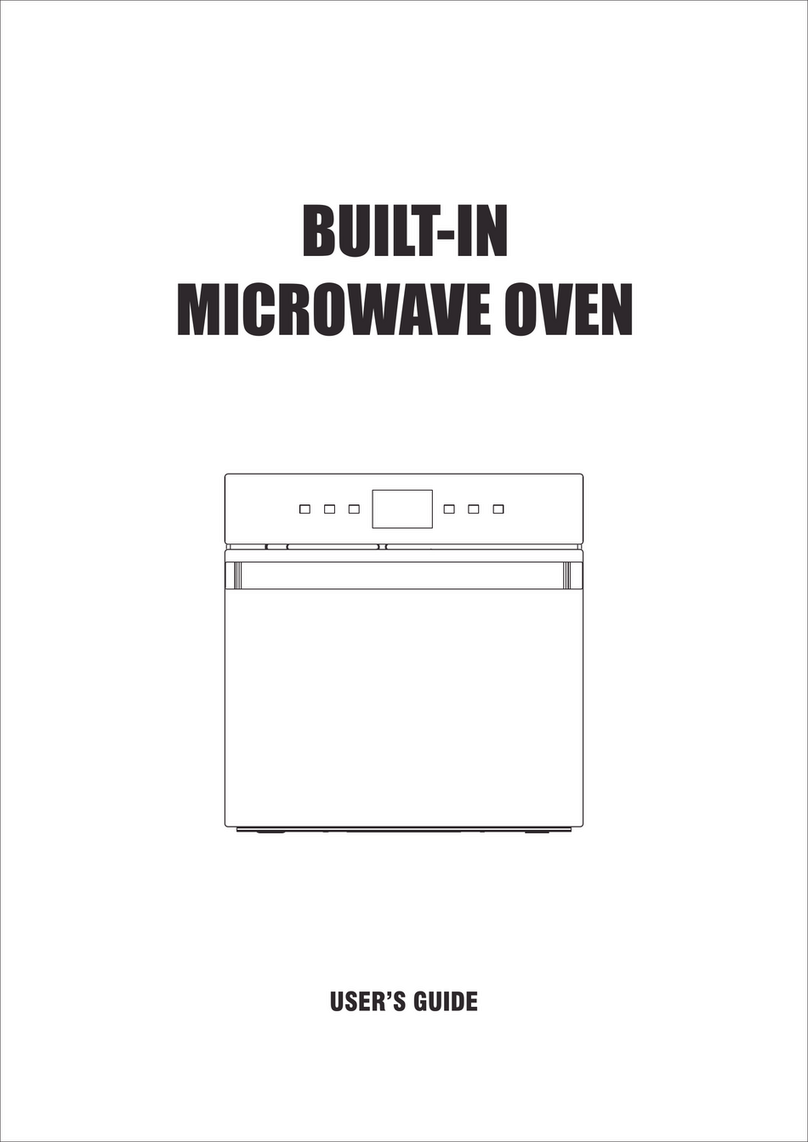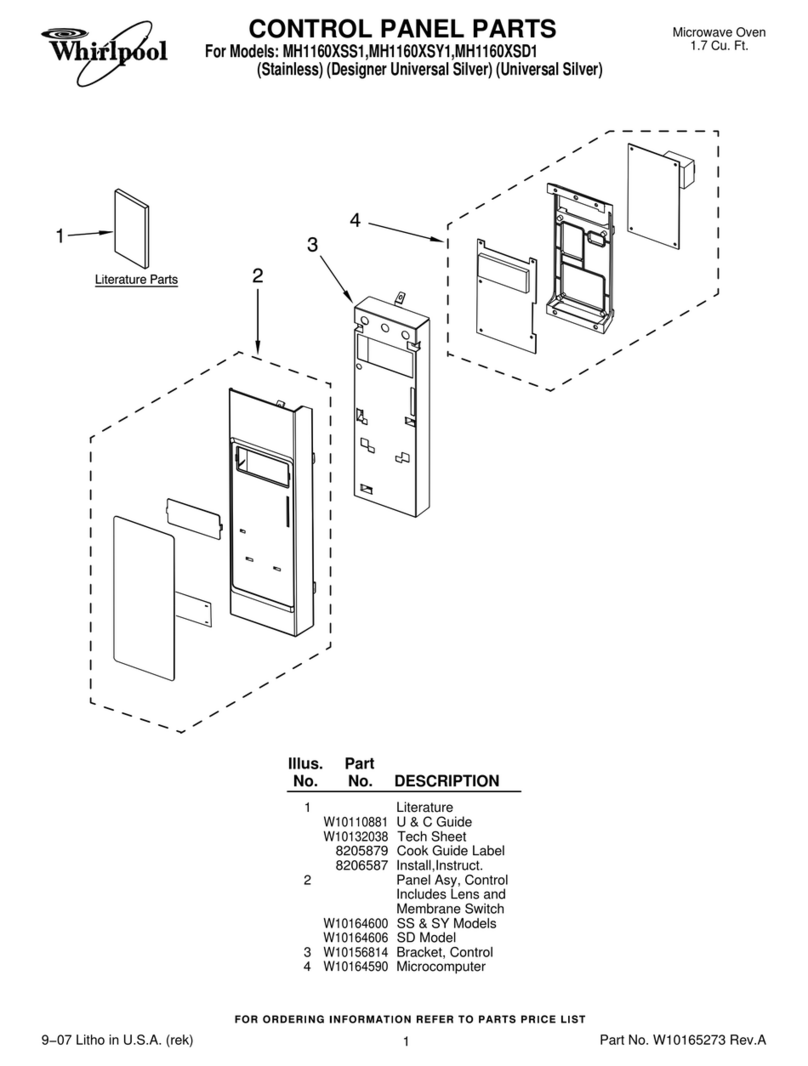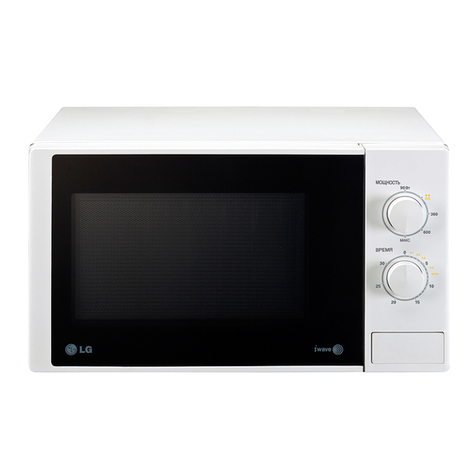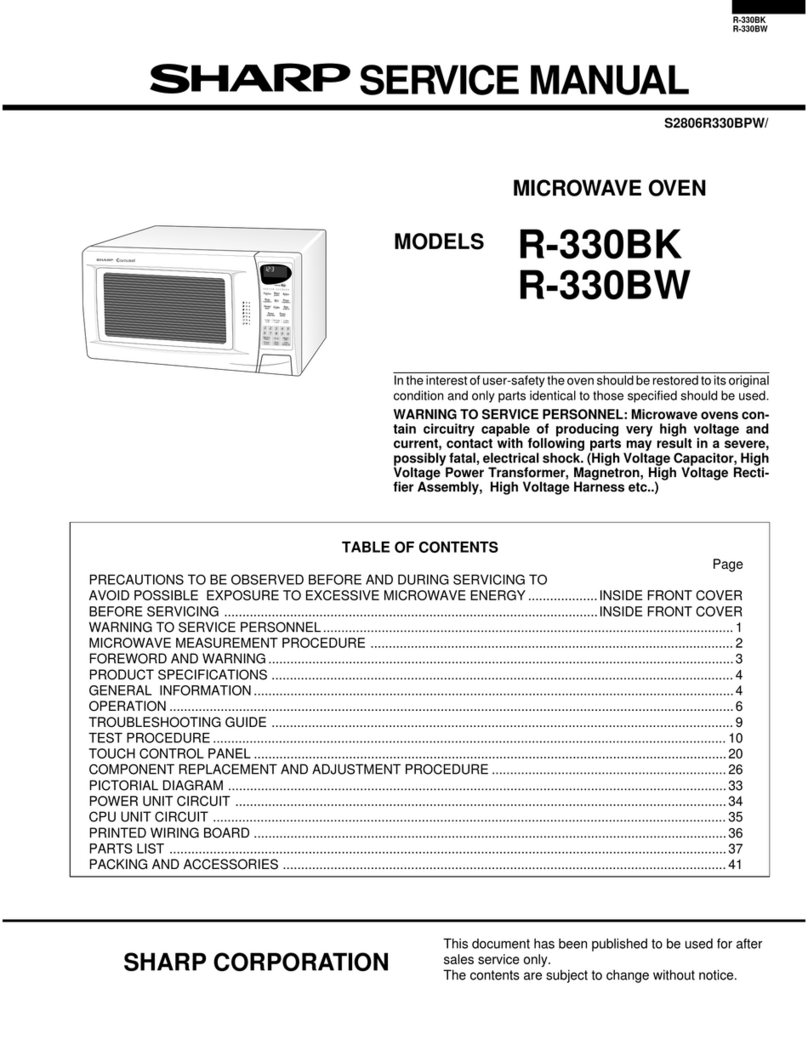ACP AOC5241 User manual

Service Manual
Commercial Microwave Oven
Style of oven handle may vary
AOC5241
MOC5241
OC5241BK
OC5241T1BK
MOC5201
MOC5201J
50 Hz
February 2016
MOC5200
MOC6200
OC24BKSA
MOC5241I
OC5241HJ
MOC5201U
16400008
Rev.2
February 2016

TABLE OF CONTENTS
IMPORTANT INFORMATION ....................................................................................................1
IMPORTANT SAFETY INFORMATION ..................................................................................2-5
Oven Specifications ..............................................................................................................6
Oven Construction ...........................................................................................................7-11
Oven Performance Test...................................................................................................................12
Component Test Procedures..........................................................................................13-16
Troubleshooting Chart....................................................................................................17-18
Wiring Diagram...................................................................................................................19
Schematic Diagram.............................................................................................................20
- ii -

1
Important Information
Important Notices for Servicers and Consumers
ACP will not be responsible for personal injury or property damage from improper service procedures. Pride and
workmanshipgointoeveryproducttoprovideourcustomerswithqualityproducts. Itispossible,however,thatduring
itslifetimeaproductmayrequireservice. Productsshouldbeservicedonlybyaqualifiedservicetechnicianwhois
familiarwiththesafetyproceduresrequiredintherepairandwhoisequippedwiththepropertools,parts,testing
instruments and the appropriate service information.
IT IS THE TECHNICIANS RESPONSIBLITY TO REVIEW ALL
APPROPRIATE SERVICE INFORMATION BEFORE BEGINNING REPAIRS.
Tolocateanauthorized servicerpleasecontact:
ComServ Support Center
WebSite
Telephone Number
WWW.ACPSOLUTIONS.COM
.......................
1-866-426-2621 or319-368-8195
E-Mail: commercialservice@acpsolutions.com
RecognizeSafetySymbols,Words,andLabels
DANGER—
Immediatehazardswhich
WILL
resultinseverepersonalinjuryordeath.
WARNING—
Hazardsorunsafepracticeswhich
COULD
resultinseverepersonalinjuryordeath.
CAUTION—
Hazards orunsafe practices which
COULD
result inminorpersonal injury, productorproperty
damage.
!
CAUTION
!
WARNING
!
DANGER
!
WARNING
Toavoidriskofseverepersonalinjuryordeath,disconnectpowerbeforeworking/servicingonappliancetoavoid
electricalshock.

2
2
Important Safety Information
!
WARNING
Readthefollowinginformationtoavoidpossibleexposuretomicrowaveradiation:
Thebasicdesignofthe MicrowaveOvenmakesitaninherentlysafedevicetobothuseandservice.
However,therearesomeprecautionswhichshouldbefollowedwhenservicingthemicrowavetomaintainthis
safety. Theseareasfollows:
1.
Always operate the unit from an adequately
groundedoutlet. Donotoperateonatwo-wire
extension cord.
2.
Beforeservicingtheunit(ifunitisoperable)perform
the microwave leakage test.
3.
Theovenshouldneverbeoperatedifthedoordoes
notfitproperlyagainsttheseal,thehingesorhinge
bearings are damaged or broken; the choke is
damaged, (pieces missing, etc.); or any other
visible damage can be noted. Check the choke
areatoensurethatthisareaiscleanandfreeofall
foreign matter.
4.
If the oven operates with the door open and
producesmicrowaveenergy,takethefollowing
steps:
A.
Telltheusernottooperatetheoven.
B.
ContactACPComServimmediately.
5.
Alwayshavetheovendisconnectedwhentheouter
case is removed except when making the "live"
tests called for in the Service Manual. Do not
reach into the equipment area while the unit is
energized. Makeallconnectionsforthetestand
checkthemfortightnessbeforepluggingthecord
into the outlet.
6.
Alwaysgroundthecapacitorsonthemagnetron
filter box with an insulated-handle screwdriver
before working in the high voltage area of the
equipmentcompartment. Sometypesoffailures
will leave a charge in these capacitors and the
dischargecouldcauseareflexactionwhichcould
makeyouinjureyourself.
7.
Always remember that in the area of the
transformer there is HIGH VOLTAGE. When the
unitisoperatingkeepthisareaclearandfreeof
anythingwhichcouldpossiblycauseanarcor
ground,etc.
8.
Do not for any reason defeat the interlock
switchesthereisnotvalidreasonforthisaction
atanytime;norwillitbecondonedbyACP.
9.
IMPORTANT: Before returning a unit to a
customer,besuretocheckforproperswitch
interlock action.
10.
TheMicrowaveOvenshouldneverbe
operatedwithanycomponentsremovedand/or
bypassedorwhenanyofthesafetyinterlocksare
found to be defective, or when any of the seal
surfacesaredefective,missing,ordamaged.
11.
All microwaveovensmeetallrequirements
oftheradiationcontrolforHealthandSafetyActof
1968. Due to measurement uncertainties, the
maximumleakageforthefieldwillbe4mw/cm2.
12.
Toensure that the unit does not emit excessive
microwaveleakageandtomeettheDepartment
ofHealthandHumanServicesguidelines,check
theovenformicrowaveleakageusingamicrowave
oven leakage meter that complies with US
Government CDRH / FDA / DHHS requirements
andoranyotherlocalgovernmentrequirements.
Themaximumleakagelevelallowed by ACP
is 4mw/cm.
13.
Ifservicerencountersanemissionreadingover
4mw/cm2,theserviceristoceaserepairand
contact the ACP ComServ Department
immediatelyforfurtherdirection.ACP
will contact the proper Government
Agencyuponverificationofthetestresults.

3
IMPORTANT SAFETY INSTRUCTIONS
Recognize this symbol as a SAFETY message
!
WARNING
When using electrical equipment, basic safety precautions should be followed to reduce the risk of burns,
electrical shock, fire, or injury to persons including the following.
1. READ all instructions before using equipment.
2. READ AND FOLLOW the specific
“PRECAUTIONS TO AVOID POSSIBLE
EXPOSURE TO EXCESSIVE MICROWAVE
ENERGY” on this page.
3. This equipment MUST BE GROUNDED. Connect
only to properlyGROUNDED outlet. See “
GROUNDING / EARTHING INSTRUCTIONS” on
page 5.
4. Install or locate this equipment ONLY in
accordance with the installation instructions in
this manual.
5. Some products such as whole eggs and sealed
containers—for example, closed glass jars—are
able to explode and SHOULD NOT be HEATED
in this oven.
6. Use this equipment ONLY for its intended useas
described in this manual. Do not use corrosive
chemicals or vapors in this equipment. This type
of oven is specifically designed to heat, cook,
or dry food. It is not designed for industrial or
laboratoryuse.
7. As with any equipment, CLOSESUPERVISION
is necessary when used byCHILDREN.
8. See door cleaning instructions on page A-4of
this owners manual.
9. DO NOT heat baby bottles inoven.
10. Baby food jars shall be open when heated and
contents stirred or shaken before consumption, in
order to avoid burns.
11 DO NOT operate this equipment if it has a
damaged cord or plug, if it is not working properly,
or if it has been damaged ordropped.
12. This equipment, including power cord, must be
serviced ONLY by qualified service personnel.
Special tools are required to service equipment.
Contact nearest authorized service facility for
examination, repair, oradjustment.
13. DO NOT cover or block louvers or otheropenings
on equipment.
14. DO NOT store this equipment outdoors. DO NOT
use this product near water –for example, near a
kitchen sink, in a wet basement, a swimming pool,
or a similar location.
15. DO NOT immerse cord or plug in water.
16. Keep cord AWAY from HEATED surfaces.
17. DO NOT let cord hang over edge of tableor
counter.
18. For commercial use only.
SAVE THESE INSTRUCTIONS
PRECAUTIONS TO AVOID POSSIBLE
EXPOSURE TO EXCESSIVE MICROWAVE
ENERGY
A. DO NOT attempt to operate this oven with the door open since open door operation can result in harmful
exposure to microwave energy. It is important not to defeat or tamper with the safety interlocks.
B. DO NOT place any object between the oven front face and the door too allow soil or cleaner residue to
accumulate on sealing surfaces.
C. DO NOT operate the oven if it is damaged. It is particularly important that the oven door close properly and
that there is no damage to the:
1. door (bent)
2. hinges and latches (broken orloosened)
3. door seals and sealing surfaces.
D. The oven should not be adjusted or repaired by anyone except properly qualified service personnel.

4
IMPORTANT SAFETY INSTRUCTIONS
Toavoid personal injury or property damage, observe thefollowing:
1. Do not deep fat fry in oven. Fat couldoverheat
and be hazardous tohandle.
2. Do not cook or reheat eggs in shell or with
an unbroken yolk using microwave energy.
Pressure may build up and erupt. Pierce yolk
with fork or knife before cooking.
3. Pierce skin of potatoes, tomatoes, and similar
foods before cooking with microwave energy.
When skin is pierced, steam escapes evenly.
4. Do not operate equipment without load orfood
in oven cavity.
5. Microwave popcorn should not be popped in
oven.
6. Do not use regular cooking thermometers in
oven. Most cooking thermometers contain
mercury and may cause an electrical arc,
malfunction, or damage to oven.
7. Do not use metal utensils inoven.
8. Do not use aluminum foil inoven
9. Never use paper, plastic, or other combustible
materials that are not intended for cooking.
10. When cooking with paper, plastic, or other
combustible materials, follow manufacturer’s
recommendations on product use.
11. Do not use paper towels which contain nylonor
other synthetic fibers. Heated synthetics could
melt and cause paper to ignite.
12. Do not heat sealed containers or plastic bags in
oven. Food or liquid could expand quickly and
cause container or bag to break. Pierce or open
container or bag before heating.
13. Toavoid pacemaker malfunction, consult
physician or pacemaker manufacturerabout
effects of microwave energy onpacemaker.
14. An authorized servicer MUST inspectequipment
annually. Record all inspections and repairs for
future use.
SAVE THESE INSTRUCTIONS
!
CAUTION
WARNING
Liquids such as water, coffee, or tea are able to
be overheated beyond the boiling pointwithout
appearing to be boiling due to surface tension of the
liquid. Visible bubbling or boiling when the container
is removed from the microwave oven is not always
present. THIS COULD RESULT IN VERY HOT
LIQUIDS SUDDENLY BOILING OVER WHEN A
SPOON OR OTHER UTENSIL IS INSERTEDINTO
THE LIQUID. Toreduce the risk of injury to persons:
i) Do not overheat the liquid.
ii) Stir the liquid both before and halfway through
heating it.
iii) Do not use straight-sided containers with narrow
necks.
iv) After heating, allow the container to stand in the
microwave oven for a short time before removing
the container.
v) Use extreme care when inserting a spoonor
other utensil into thecontainer.
WARNING
Toavoid risk of fire in the oven cavity:
a. DO NOT overcook food. Carefully attend oven
when paper, plastic, or other combustible
materials are placed inside the oven to facilitate
cooking.
b. Remove wire twist-ties from paper or plastic
bags before placing bag inoven.
c. If materials inside the oven ignite, keep oven
door CLOSED, turn oven off and disconnect
the power cord, or shut off power at the fuseor
circuit breaker panel.
d. DO NOT use the cavity for storage. DO NOT
leave paper products, cooking utensils, or food
in the cavity when not in use.

5
Important Safety Information
GroundingInstructions
This equipment
MUST
begrounded.Intheeventofan
electricalshortcircuit,groundingreducestheriskof
electric shock by providing an escape wire for the
electric current. Thisoven isequipped with acord
havingagroundingwirewithagroundingplug.Theplug
mustbepluggedintoanoutletthatisproperlyinstalled
and grounded.
Consultaqualifiedelectricianorservicerifgrounding
instructionsarenotcompletelyunderstood,orifdoubt
exists as to whether the equipment is properly
grounded.
Donotuseanextensioncord.Iftheproductpowercord
istoo short, have a qualified electrician install an appropriate
receptacle. This ovenshould beplugged intoa
separate50or60hertzcircuitwiththeelectricalratingas
shownintheappropriatedrawing.Modelsoperatewitha
208 or230supplyvoltage.Whenanovenisona
circuitwithotherequipment,anincreaseincooking
times maybe requiredandfusescan beblown.
!
WARNING
Toavoidtheriskofelectricalshockordeath,this
equipment must be grounded.
!
WARNING
Toavoidtheriskofelectricalshockordeath,donot
altertheplug.
!
WARNING
Do not remove grounding prong when installing
groundedapplianceinahomeorbusinessthatdoes
nothavethreewiregroundingreceptacle,underno
conditionisgroundingprongtobecutofforremoved.
Itisthepersonalresponsibilityoftheconsumerto
contactaqualifiedelectricianandhaveproperly
groundedthreeprongwallreceptacleinstalledin
accordancewithappropriateelectricalcodes.
!
WARNING
Toavoidriskofelectricalshock,injuryordeath;make
sure these grounding instructions are followed.
PRECAUTIONS TO BE
OBSERVED BEFORE AND
DURING SERVICING TO
AVOIDPOSSIBLEEXPOSURE
TO EXCESSIVE MICROWAVE
ENERGY, OR ELECTRICAL
SHOCK. DISCONNECT
POWER TOOVEN.
•
Donotoperateorallowoventobeoperatedwith
dooropen.
•
Makethefollowingsafetychecksonallovenstobe
servicedbeforeactivatingthemagnetronorother
microwavesource,and makerepairsasnecessary:
•
Interlock operation
•
Proper doorclosing
•
Seal and sealing surfaces (arcing, wear, and
otherdamage)
•
Damage toorlooseningofhingesand latches
•
Evidenceof droppingorabuse
•
Before turning on microwave power for anyservice
test or inspection within the microwave generating
compartments,checkthemagnetron,waveguideor
transmission line, and cavity for proper alignment,
integrity, andconnections.
•
Any failed or misadjusted components in the
interlock, monitor, door seal, and microwave
generation and transmission systems shall be
repaired,replacedoradjustedbyprocedures
described in this manual before oven isreleased to
theconsumer.
•
Check microwave leakage to verify compliance
with thefederal performance standard should be
performedoneachovenpriortoreleasetothe
consumer.
!
WARNING

6
SPECIFICATIONS
Model
AOC5241 / MOC5241 / OC5241 / MOC5201 / MOC5201J
Configuration
Countertop or shelf
Control System
Touch, angled for easy viewing
Programmable Control Pads
10
Total Programmable Settings
100
Max. Cooking Time
10:00
Power Levels
11
Defrost
Yes
Time Entry Option
Yes
Microwave Distribution
Rotating antennas, top and bottom
Magnetrons
2
Display
LED
Stackable
Yes
Stage Cooking
Yes, 4
Door Opening
Automatic opening
Signal
Door opens automatically
Temp. Display
N/A
Exterior Dimensions
D** 473mm (18 ⅝”)W 346mm (13⅝”) H 451mm (17 ¾”)
Cavity Dimensions
D 222mm (8 ¾”) W 298mm (11¾”) H 136mm (5 ⅜”)
Door Depth
n/a
Usable Cavity Space
9 Liters (.319 cubic ft.)
Exterior Finish
Stainless steel
Interior Finish
Stainless steel
Power Consumption
3100 W
Power Consumption(MOC5201*)
2650 W
Power Output*
2400 W* Microwave
Power Output* (MOC5201*)
2000 W* Microwave
Power Source
230V, 50 Hz, 16 A single phase
Power Source(MOC5201*)
200V, 50 Hz, 16 A single phase
Plug Configuration / Cord
CEE7/7 “Schuko” (133mm)
Plug Configuration / Cord (MOC5201)
Meltric DS3
Plug Configuration / Cord (MOC5201J)
20 A Twist Lock
Frequency
2450 MHz
Product Weight
32 kg. (70 lbs.)
Ship weight (approx.)
33 kg. (73 lbs.)
Shipping Carton Size
H 524mm (20 ⅝”) W 432mm (17”)
H 559mm (22”)
Measurements in ( ) and not specified
are millimeters
* IEC 705 Tested
** Includes handle

7
OVEN CONSTRUCTION-
Left Outer Panel
Top Outer Panel
Right Outer Panel
Door
Left Outer
Panel
TopOuter
Panel
10
Right Outer
Panel
Door

8
OVEN CONSTRUCTION-
Touch Panel Assembly
Escutcheon Control
Display Board
Retainer Clip
TouchPanel
Assembly
DisplayBoard
Retainer
Clip
Escutcheon
Control
Main ControlBoard
2.5 Amp Fuse
Fan Motor
Fan Guard
40 pin Header Bracket
2.5 Amp
Fuse
Main Control
Board
40 Pin
Header Bracket
Fan Motor
FanGuard

9
OVEN CONSTRUCTION-
Antenna
Antenna Motor
InterlockSwitch
Solenoid Assy
Interlock
Switch
(Right Side)
Diode
Capacitor
Magnetron
Magnetron Gasket
Magnetron TCO
Latch TCO
PC Board Harness
Antenna
(Top)
Antenna Motor
(Bottom)
Solenoid Assembly
(Right Side)
Diodes
Capacitors
Magnetrons
Magnetron
Gaskets
PC Board
Harness
LatchTCO
Magnetron
TCO

10
OVEN CONSTRUCTION-
Antenna (Bottom)
Grease Shield
Ceramic Tray
TraySupport
Glide Strip
20 Amp Fuse
HV Transformer
Triac 40A
Control Transformer
Line Filter
20 Amp
Fuse
Line Filter
HV Transformer Triac 40A Control
Transformer
Grease
Shield
Ceramic
Tray
Glide
Strip
Antenna
(Bottom)
Tray Support

11
OVEN CONSTRUCTION-
Lower Back Panel
Cavity Exhaust Gasket
Cavity Exhaust FanMotor
Cavity TCO
Cavity Fan Hood
CavityExhaust
Motor Gasket
Lower Back
Panel
CavityExhaust
Fan Motor
Cavity Fan
Hood
CavityTCO
Hinge Assembly
Hinge Spring
Hinge Assembly
Hinge Spring

12
OVEN PERFORMANCE TEST
All Amana and Menumaster microwave oven power outputs are rated using the IEC705 standards. Using the
IEC705 test method requires precision measurements and equipment that is not practical to be performed in the
field. Using the test shown below will indicate if the oven performance is satisfactory.
Testequipmentrequired:
1000 ml test container and thermometer.
Digital watch / watch with a second hand for use on ovens with electromechanicaltimers.
ImportantNotes:
Low line voltage will cause low temperature rise / poweroutput.
Ovens must be on a dedicated circuit, properly grounded, and polarized. Other equipment on the same
circuit may cause a low temperature rise / poweroutput.
This test and results are not a true IEC705 test procedures and are only intended to provide servicers with
an easy means of determining if the microwave oven cooking output is correct.
Procedure
1. Fill the test container to the 1000 ml line with cool tap water.
NOTE:
Water temperature should be approximately 60
F /16
C
2. Using the thermometer, stir water for five to ten seconds; measure, and record the temperature (T1).
3. Place test container of water in the center of oven cavity and closedoor.
4. Heat the water for a 33-second full powercycle.
NOTE:
Use a digital watch or a watch with a second hand for ovens with electromechanical timers.
5. At end of the cycle, remove test container. Using the thermometer, stir water for five to ten seconds and record
temperature (T2).
6. Subtract the starting water temperature (T1) from the ending water temperature (T2) to obtain the temperature
rise (
∆
T).
7. If the temperature rise (
∆
T) meets or exceeds the minimum, the test is complete. If the temperature rise (
∆
T)
fails to meet the minimum temperature rise, test the line voltage to verify it is correct. Then repeat steps 1 - 6
making sure to change the water. If the temperature rise (
∆
T) fails to meet the minimum temperature rise again
the oven will require service.
Minimum Temperature Rise at Thirty (30) Seconds Run Time
∆T Cooking
(°F) Power Output
∆T Cooking
(°F) Power Output
∆T Cooking
(°C) Power Output
∆T Cooking
(°C) Power Output
10..................1000
20..................2000
5 ...............1000
11 ............2000
11..................1100
21..................2100
5.5.............1100
11.5 .........2100
12..................1200
22..................2200
6.5.............1200
12 ............2200
14..................1400
24..................2400
7.5.............1400
13 ............2400
17..................1700
25..................2500
9.5.............1700
13.5 .........2500
18..................1800
27..................2700
10..............1800
15 ............2700
19..................1900
30..................3000
10.5...........1900
16.5 .........3000

13
COMPONENT TESTING PROCEDURES
Illustration
Component
Testing
Results
Magnetron TCO
Disconnect all wires from TCO.
Measure resistance across terminals.
Magnetron TCO.....................................
Closed at 257ºF (125ºC) and
Opens at 300ºF (149ºC)
Latch TCO
Disconnect all wires from TCO.
Measure resistance across terminals.
Latch TCO.............................................
Opens at 230ºF (110ºC) and
Closes at 150ºF (66ºC)
Cavity TCO
Disconnect all wires from TCO.
Measure resistance across terminals.
Cavity TCO............................................
Opens at 219ºF (104ºC)
Diode
Discharge Capacitor
Remove diode lead from capacitor and
connect ohmmeter.
Reverse leads for second test.
Infinite resistance should be
measured in one direction and50K
or less in the opposite direction.
NOTE:
Ohmmeter must contain a
battery of 6 voltsminimum.
Triac
Resistance Check
Disconnect wires to triac
Measure resistance from:
MT1 to MT2
MT1 to Gate
MT2 to Gate
All terminals to ground
Caution –Do not operate oven with
wire to terminal MT2 removed
.
Infinite
Approximately 60Ω
Infinite
Infinite
Voltage Check
Measure voltage from:
MT1 to Gate
MT1 to MT2
0.8 VAC when energized.
0 volts when gate energized or closed.
Line volts when gate not energized or
open.
Capacitor
Discharge Capacitor
Remove wires from capacitor terminals
and connect ohmmeter, set on highest
resistance scale to terminals.
Also check between each terminal and
capacitor case.
Between Terminals: Meter should
momentarily deflect towards zero then
return to over 5 M
. If no deflection
occurs, or if continuous deflection
occurs, replace capacitor.
Terminal to Case: Infinite resistance
Magnetron
Discharge Capacitor
Remove wires from magnetron and
connect ohmmeter to terminals. Also
check between each terminal and
ground.
Between Terminals: Less than 1
Each terminal to ground measures
Infinite resistance.
Note:
This test is not conclusive. If
oven does not heat and all other
components test good replace the
magnetron and retest.
Solenoid (Left, Right)
Disconnect connector from solenoid
Measure resistance across coil.................
Approximately 6-11
Stirrer motor
Remove all wires from motor.
Measure resistance across terminals....
Approximately 12K
!
WARNING
Toavoid risk ofelectrical shock, personal injury or death; disconnect power to oven and discharge capacitor
beforeservicing, unlesstestingrequires power.

14
COMPONENT TESTING PROCEDURES
Illustration
Component
Testing
Results
Transformer, HV
Discharge Capacitor
Remove all wires from terminals.
Measure resistance from:
230 to COM..........................................
Less than 1
208 to COM..........................................
Less than 1
230 to Ground
Infinite
208 toGround----------------------------------
Infinite
Terminal 5 to 6---------------------------------
Less than 1
Terminal 7 to 8---------------------------------
Less than 1
Terminal 4 to Ground-------------------------
Approximately 27
Main board
See Main Board page 5
Left interlock switch assembly
Disconnect wires to switch.
With door open measure resistance from:
Monitor –Terminals Rd- Bk..............
Primary –Terminals Bk - Brn ...........
With door closed measure resistance from:
Monitor –Terminals RD - BK ...........
Primary –Terminals BK - BN ...........
After verifying or replacing the
assembly, re-connect wires to switch
and check operation of monitor circuit
before operating the oven.
(Mechanical)
Indicates continuity
Infinite
Infinite
Indicates continuity
Right interlock switch
Disconnect wires to switch.
With door open measure resistance from:
Monitor –Terminals RD- BK ............
Secondary –Terminals GY -RD.......
With door closed measure resistance from:
Monitor –Terminals RD - BK ...........
Secondary –Terminals GY - RD......
After verifying or replacing the
assembly, re-connect wires to switch
and check operation of monitor circuit
before operating the oven.
assembly
(Mechanical)
Indicates continuity
Infinite
Infinite
Indicates continuity
Transformer, control
(1) BU to (5) BR ----------------------------- --
Approximately 40 or Line Voltage
(6) YL to (10)WH-------------------------------
Approximately 1 or 28 VAC
Fan, cooling
Disconnect connector from fan.
Measure voltage at incoming leads...........
Approximately 24VDC
Fan, exhaust
Disconnect connector from fan.
Measure voltage at incoming leads .......
Approximately 24VDC
!
WARNING
To avoid risk of electrical shock, personal injury or death; disconnect power to oven and discharge capacitor
before servicing, unless testing requires power.

15
COMPONENT TESTING PROCEDURES
Main. Board
Function
Test Set-Up
Meter
Setting
ProbePlacement
Results
Input to mainboard
Left, Right Switch
Assembly
Main Board
(DoorClosed)
Volts
Main Board T-1
(Black wire)
Triac (Redwire)
Line voltage
J4 Inputfrom
Control
Transformer
Main Board
Volts
J4-1 & J4-2
28 VAC
!
WARNING
To avoid risk of electrical shock, personal injury or death; disconnect power to oven and discharge capacitor
before servicing, unless testing requirespower.

16
COMPONENT TESTING PROCEDURES
Function
Test Set-Up
Meter Setting
ProbePlacement
Results
2.5 amp fuse
Note:
If Fuse isblown
unit is nonoperational
Fuse is field
`replaceable.
Remove fusefrom
holder
Ohms
Measureresistance
across fuse
Continuity
J1 TriacOutput
Connection
Orange wire toRed
wire
Volts
Orange wire at Traic
Connection. Redwire
at TriacConnection
0.8 VAC when
Triacenergized
Power Relay
T3 to Blue wire atJ1
Triacconnection
T4 to Blue wire atJ1
TriacConnection
Volts
Volts
T3 to Blue wireat
TriacConnection
T4 to Blue wireat
TriacConnection
Line volts when
voltagepresent
Line volts when
voltagepresent
Illustration
Component
Test
Pad
Results
Keypad
Removal of touch panel is requiredto
Trace
Measurement
perform test.
1
8 & 10
Continuity
Continuity is indicated as 100 and
2
7 & 10
Continuity
below.
3
6 & 10
Continuity
4
5 & 10
Continuity
5
4 & 10
Continuity
6
3 & 10
Continuity
7
8 & 9
Continuity
8
7 & 9
Continuity
9
6 & 9
Continuity
0
5 & 9
Continuity
Start
4 & 9
Continuity
Stop
4 & 8
Continuity
Power Level
5 & 8
Continuity
Time Entry
7 & 8
Continuity
!
WARNING
To avoid risk of electrical shock, personal injury or death; disconnect power to oven and discharge capacitor
before servicing, unless testing requires power.

17
Open Door
Yes
TROUBLESHOOTING CHART
Intial Power-Up
(Door Open)
No
No
Operation Normal
Close Door Then OpenDoor
Connect Power Cord
1. No power applied to powercord.
2. Oven fuseopen.
3. Main board controlfuse.
4. Inoperative magnetronTCO.
5. Inoperative cavityTCO.
6. Broken or loosewire.
7. Inoperative controltransformer.
8. Ribbon connector.
9. Inoperative displayboard.
1. Check interlockswitches.
2. Check T1connection.
3. CheckJ1-1 connection.

18
Fans Run
Placecupofwaterinoven
and close door
Press Pad 1
Display starts countingdown
Door opens at end ofcycle
Water is heated
Cook Condition TROUBLESHOOTING CHART
No
Yes
No
Yes
No
Yes No
Yes
No
Yes
Oven is operatingproperly
1. Inoperative doorlatch.
2. Broken or loose wireconnection.
1. Door not closed.
2. Inoperative switchassembly.
3. Broken or loose wireconnection.
1. Bad fan.
2. Broken or loose wireconnection.
1. Inoperative touchpanel.
2. Bad ribbon cable.
Heats very slowly.
Note: Verify by performing powertest.
1. Inoperative high voltagetransformer.
2. Inoperativecapacitor.
3. Inoperativemagnetron.
4. Inoperativediode.
5. Broken or loose wireconnection.
No heat.
1. Inoperativetriac.
2.Inoperative high voltageboard.
3. Inoperative high voltagetransformer.
4. Broken or loose wireconnection.
Other manuals for AOC5241
1
This manual suits for next models
11
Table of contents
Other ACP Microwave Oven manuals
